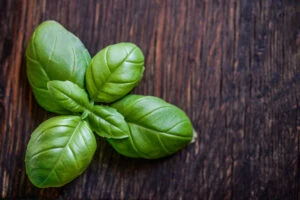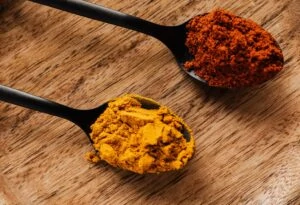I’d never heard of baharat, but when I read the ingredient list of this delicious Middle Eastern spice mix, I realized I’ve created it on accident many times when experimenting with Middle Eastern marinated olives. So here’s the scoop so you can make this wonderful spice yourself or pinpoint it in your next ethnic food stop.
What is Baharat made of?
Baharat is a Middle Eastern spice mix that varies in ingredients depending on where it is made. It is recognized by its sweet, smoky flavor and its rusty color that is due to the nutmeg, paprika, cinnamon, and cumin.
The standard ingredients in baharat include any variation of coriander, cumin, cloves, cinnamon, cardamom, black pepper, and paprika. Turkish baharat includes dried mint, and North Africa adds dried rosebuds. Some other combinations include saffron, sumac, chili peppers, and turmeric for variation in color or the addition of spicy heat.
What Does Baharat Taste Like?
Baharat tastes similar to India’s garam masala. It has a strong aroma and its spice blend is earthy, warm, sweet and smoky with no spicy heat. Since its flavor and aroma are very powerful, it is best to go easy on this spice.
How to make your own Baharat
Baharat is simple to make. You’ll need a grinder such as a spice grinder, mortar and pestle, or coffee grinder like these grinding tips we also use for coffee. While the quantities and ingredients in baharat differ depending on the cook’s preference, here is a delicious blend:
- 4 parts black pepper
- 4 parts cumin seeds
- 3 parts cinnamon
- 3 parts cloves
- 3 parts coriander seed
- 1 part cardamom pods
- 6 parts paprika
- 3 parts nutmeg
Combine the first six ingredients and grind until they are fine, then add the powdered nutmeg and paprika and give the mixture a last grind.
Tip: Toasting the spices in a dry skillet over low heat before grinding them is a delicious twist for a smokier flavor.
Where Can I Buy Baharat Spice?
Baharat is most commonly found in Middle Eastern stores and occasionally in grocery specialty isles. Online, baharat spice mix can be bought by the bag-full, if you’re ready to jump in headfirst, or by the 2-ounce jar.
How to Store
Baharat is best stored in an air-tight container in a cool, dark place like your kitchen pantry. You can store both homemade and store-bought baharat this way for up to three months. Homemade is always fresher.
Is Baharat the same as Ras el Hanout?
Middle Eastern Baharat and Moroccan Ras el Hanout are similar, but Ras el Hanout Moroccan spice differs in taste and lesser popularity. It includes several other extraordinary spices like guinea pepper berries, ash tree fruit, and cubeb berries, and it is used more sparingly than Baharat.
Can you Buy Fresh Baharat?
You can buy baharat spices unground and make your own. Unground spices used in baharat are often found in the bulk section of large grocery stores, and most grocery stores also carry each spice in the baking or spice isle in small jars. Occasionally it is difficult to find coriander and cardamom in their unground form.
What is a Substitute for Baharat?
Besides making your own baharat when you’re out of store-bought ease, there are a couple of options that you use as replacements.
If you’re out of baharat’s full ingredient list, you can make an incomplete yet similar flavor combination in a pinch. Combine equal parts paprika, cumin, and cinnamon or more ground cumin, and replace the recipe’s called-for quantity of baharat in equal parts.
The best substitute for baharat is seven spice, because the two are the same but with different names. The term seven spice is Lebanese, whereas baharat is the common Arabic term for the same spice mix.
One of the most common substitutes for baharat is its cousin, garam masala. While the flavor will not be equal, you can replace baharat with garam masala in a ratio of 1:1. Garam masala best matches the flavor of baharat that is toasted.
A possible but drastically different baharat substitution in za’atar seasoning. Za’atar is not recommended as a replacement for baharat because it is made of a very different mix of herbs which offers a much sweeter, zingy flavor.
Dukkah is not recommended as a replacement for baharat either, as it is most similar to za’atar but with a crunchier texture and nuttier flavor.
Best Ways to Cook with Baharat
Baharat is primarily used in Middle Eastern cuisine. It can be found in Middle Eastern lamb rub, Middle Eastern pita bread, and Middle Eastern-style roasted vegetables. Here are a few tips to keep in mind when cooking with baharat:
- Use baharat in marinades or spice rubs by combining with lemon juice, olive oil, and salt.
- Use baharat in recipes including ground beef by mixing the spice into the meat before cooking. For every pound of ground beef use 1 teaspoon of baharat.
- Recipes calling for baharat may specify toasting the spices before grinding them into a powder yourself. If not, the powder is added as-is.
- Always work with baharat in small amounts and increase if you prefer after sampling the well-cooked recipe.
Flavor Pairings with Baharat
Baharat pairs well with vegetables and meats like beef, chicken, seafood, and lamb. It is often used in soups and stews or as a dish finisher or condiment.











